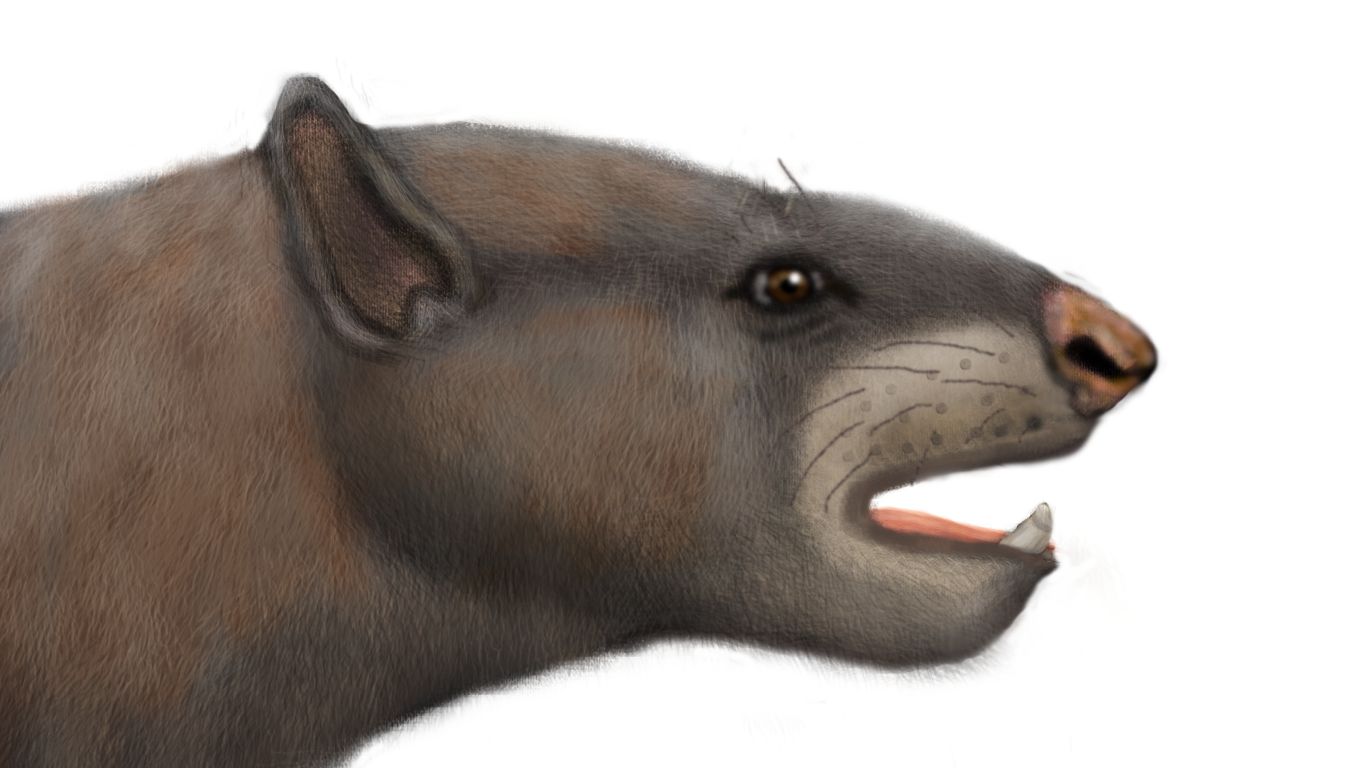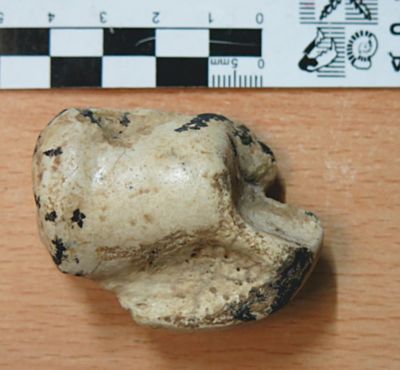|
Trigonostylops
''Trigonostylops'' is an extinct genus of South American meridiungulatan ungulate, from the Late Paleocene to Late Eocene (Itaboraian to Tinguirirican in the SALMA classification) of South America (Argentina and Peru) and Antarctica (Seymour Island). It is the only member of the family Trigonostylopidae. Description A complete skull of the type species, ''T. wortmani'', has been found, and it has been classified as an astrapothere based on its large lower incisors. Phylogeny Cladogram based in the phylogenetic analysis published by Vallejo Pareja ''et al''., 2015, showing the position of ''Trigonostylops'':Vallejo Pareja et al., 2015 Distribution Fossils of ''Trigonostylops'' have been found in:''Trigonostylops'' at |
Tetragonostylops
''Tetragonostylops'' is an extinct genus of mammal, related to Astrapotheria. It lived during the Late Paleocene, and its fossils were discovered in South America. Description This genus is only known from incomplete remains, notably a well-preserved mandible and a fragmentary skull. Like other astrapotheres, ''Tetragonostylops'' may have had a strong elongated body, and a long, flat skull. The skull was 20 centimeters long, and the entire body was supposedly one meter long. Its mandible was strong, and endowed with an elongated cylindrical symphysis. The mandibular condyle was elevated, and the coronoid process was high, but lower than in its relative ''Trigonostylops''. The shape of their molars was different, with ''Tetragonostylops'' having more squared molars (hence his name, ''Tetragon-'' meaning "four corners"), and had an infraorbital canal, which does not appear in ''Trigonostylops''. The molars were brachyodont, like those of ''Trigonostylops'', and the canines were st ... [...More Info...] [...Related Items...] OR: [Wikipedia] [Google] [Baidu] |
Eoastrapostylops
''Eoastrapostylops'' is an extinct genus of astrapothere that lived during the Late Paleocene in what is now Argentina. Description This animal was small in size; the skull was 9 centimeters long and the total length of the animal probably just exceeded half a meter. ''Eoastrapostylops'' possessed a short muzzle ; its canines were well developed but not yet derived into large fangs, as was the case in later South American ungulates such as ''Trigonostylops'', and the nasal bones were not retracted, indicating the absence of the typical proboscis exhibited by later forms. The dentition of ''Eoastrapostylops'' recalls that of its later relative, ''Trigonostylops''. molars and premolars were low-crowned and lophoselenodont-shaped. The fourth premolar was molarized, while both the fourth upper premolar and the third upper molar were triangularly shaped and lacked an hypoconus. Classification ''Eoastrapostylops riolorense'' was first described in 1981, based on fossils found in the ... [...More Info...] [...Related Items...] OR: [Wikipedia] [Google] [Baidu] |
Riochican
The Riochican ( es, Riochiquense) age is a period of geologic time (57.0–54.0 Ma) within the Paleocene and Eocene epochs of the Paleogene, used more specifically within the South American land mammal ages (SALMA). It follows the Peligran and precedes the Itaboraian age. Etymology This age is named after the Río Chico Group of the Golfo San Jorge Basin The Golfo San Jorge Basin ( es, Cuenca del Golfo San Jorge) is a hydrocarbon-rich sedimentary basin located in eastern Patagonia, Argentina. The basin covers the entire San Jorge Gulf and an inland area west of it, having one half located in Sant .... Formations Fossils References Bibliography ;Bogotá Formation * * * ;Bororó Formation * ;Chota Formation * * ;Las Flores Formation * ;Koluel Kaike Formation * ;Maíz Gordo Formation * ;Mealla Formation * ;Mogollón Formation * * ;Muñani Formation * ;Peñas Coloradas Formation * * ;Río Loro Formation * ;Salamanca Formation * * * ... [...More Info...] [...Related Items...] OR: [Wikipedia] [Google] [Baidu] |
Astraponotus
''Astraponotus'' is an extinct genus of astrapotheriids. It lived during the Middle-Late Eocene (in the Mustersan and Tinguirirican of the South American land mammal ages (SALMA), 48-33.9 million years ago) and its fossil remains have been found in the Sarmiento Formation of Argentina, South America.''Astraponotus'' at .org Description Unlike most astrapotheres, ''Astraponotus'' was equipped with an unusually high, short, narrow skull. The nasal bones were quite withdrawn, which suggests the presence of a short proboscis. Other unusual features of ''Astraponotus'' includes the extreme reduction of the |
Meridiungulata
South American native ungulates, commonly abbreviated as SANUs, are extinct ungulate-like mammals of controversial affinities that were indigenous to South America prior to the Great American Biotic Interchange. They comprise five major groups conventionally ranked as orders— Astrapotheria, Litopterna, Notoungulata, Pyrotheria, and Xenungulata—as well as some other taxa, such as Didolodontidae and Kollpaniidae. It has been proposed that some or all of the members of this group form a clade, named Meridiungulata, though the relationships of South American ungulates remain largely unresolved. The two largest groups of South American ungulates, the notoungulates and the litopterns, were the only groups to persist beyond the mid Miocene. Only a few of the largest species of notoungulates and litopterns survived until the end-Pleistocene extinctions. Though most SANUs lived in South America, astrapotheres and litopterns are known from Eocene aged deposits in the Antarctic Pe ... [...More Info...] [...Related Items...] OR: [Wikipedia] [Google] [Baidu] |
Itaboraian
The Itaboraian ( pt, Itaboraiense) age is a period within the Early Eocene geologic time (53.0–50.0 Ma) epoch of the Paleogene, used more specifically with South American land mammal ages (SALMA). It follows the Riochican and precedes the Casamayoran age. Etymology This age is named after the Itaboraí Formation in the Itaboraí Basin in Itaboraí Itaboraí (, ) is a city in the state of Rio de Janeiro in Brazil, that belongs to the Rio de Janeiro metropolitan area. It was founded in 1672. In 2020, it had a population of 242,543. Location Culturally, its closest municipalities are São ..., a Greater Rio municipality in the state of Rio de Janeiro in Brazil not very far away from Niterói. Formations Fossils Correlations References Bibliography ;Itaboraí Formation * * * * * * ;Bogotá Formation * * * ;Cerrejón Formation * * * * * * * * * * * * * ;Chota Formation * * ;Las Flores Formation * * * ;Koluel Kaike ... [...More Info...] [...Related Items...] OR: [Wikipedia] [Google] [Baidu] |
Scaglia (mammal)
''Scaglia'' is an extinct genus of South American astrapotherid land mammal that lived during the Eocene (Casamayoran to Divisaderan in the SALMA classification). Etymology The genus was named after Argentinian naturalist Galileo Juan Scaglia, and the type species after Argentinian palaeontologist Lucas Kraglievich. Description Its type specimen, recovered from the Sarmiento Formation of Argentina, is MMCNT-MdP 207. Like ''Albertogaudrya'', ''Scaglia'' was the size of a sheep or a small tapir, hence among the larger mammals in South America at that time. Phylogeny Cladogram A cladogram (from Greek ''clados'' "branch" and ''gramma'' "character") is a diagram used in cladistics to show relations among organisms. A cladogram is not, however, an evolutionary tree because it does not show how ancestors are related to d ... according to Bond ''et'' al., 2011, standing out the phylogenetic position of ''Scaglia'': References Bibliography * * Further rea ... [...More Info...] [...Related Items...] OR: [Wikipedia] [Google] [Baidu] |
Maddenia (mammal)
''Maddenia'' is an extinct genus of astrapothere, meridiungulate herbivore mammals characterised by its large tusks and the development of proboscis, endemic of South America. This genus was discovered in an outcrop near to the Lake Colhué Huapi in the place La Cantera, in the Chubut Province, in Argentina, in sediments corresponding to the Sarmiento Formation, that dates of the Late Oligocene (Deseadan South American land mammal age).''Maddenia'' at .org [...More Info...] [...Related Items...] OR: [Wikipedia] [Google] [Baidu] |
Hilarcotherium
''Hilarcotherium'' is an extinct genus of astrapotheriid mammals that lived in South America during the Middle Miocene ( Laventan). The type species is ''H. castanedaii'', found in sediments of the La Victoria Formation, part of the Honda Group in the department of Tolima in Colombia. In 2018, Carrillo ''et al.'' described a partial skull and mandible of a second species ''H. miyou'' from the Castilletes Formation in the Cocinetas Basin of northern Colombia, and estimated the body weight of the animal at .Carillo, 2018, p.142 Discovery The remains of ''Hilarcotherium castanedaii'' were discovered by José Alfredo Castañeda, who found them in the Malnombre Creek in the Hilarco village located near the town of Purificación, in Tolima. This area, in the valley of the Upper Magdalena River, correspond to the La Victoria Formation, that along with the Villavieja Formation makes the Honda Group, dating from the Middle Miocene, made between 13-11.8 million years ago and it has pr ... [...More Info...] [...Related Items...] OR: [Wikipedia] [Google] [Baidu] |
Astrapotherium
''Astrapotherium'' ("lightning beast") is an extinct genus of South American mammals that vaguely resembled a small elephant or large tapir. However, it was unrelated to elephants or tapirs, but was instead related to other extinct South American ungulates. Fossils have been dated from the Early to Middle Miocene. Fossil remains of the type species ''A. magnus'' have been found in the Santa Cruz Formation in Argentina. Other fossils have been found in the Deseado, Sarmiento, and Aisol Formations of Argentina and Chile (Cura-Mallín Group).''Astrapotherium'' at .org Description [...More Info...] [...Related Items...] OR: [Wikipedia] [Google] [Baidu] |
Uruguaytherium
''Uruguaytherium'' is an extinct genus of astrapotherid mammal from the Late Oligocene to Early Miocene of South America. It was named by the Argentinean paleontologist Lucas Kraglievich in 1928, from a fragmentary fossil found in the Fray Bentos Formation of the department of Río Negro in Uruguay, and the type species is ''U. beaulieui''.''Uruguaytherium'' at .org The related genera '''' and '' |




